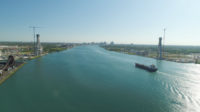 N-7 project featured design-build and lane rentals.
|
"We have a backlog of work in roads to complete," says John McGowan, president of Engineers Ireland, which has 22,000 members. Invoking the example of the U.S. Interstate system, he says, "We only now have the resources and methods for delivering that here."
The resources come from the Irish government's Transport 21 initiative, which will cost $45.8 billion between 2006 and 2015. Major goals include the development of a city-to-city motorway network by 2010, improvements in the rest of the national road network, and major transit projects.
 McGowan
|
The influx of opportunities has cemented the long-term joint venture of London-based Halcrow Group Limited and Dublin-based J.B. Barry & Partners. The consulting engineer joint venture, called Halcrow Barry Ltd., worked on a $310-million design-build project to widen N-7 in County Kildare and currently is working on the new $604-million N-8 route in Cashel, two hours south of Dublin.
On N-7, the contractor, Clonmel Enterprises and Laing O’Rourke JV, rebuilt four interchanges and “rubbilized” the existing concrete slabs, up to 20 m long each, by dropping controlled weights to break them up, says Sean O’Flaherty, a contractor official. With the Ryder Cup looming in September 2006, the joint venture had to finish the 14 miles of widened roadway and 14 km of regional roads in less than two years. It faced potential fines of 56,000/week plus fines for exceeding permitted lane “rentals”. Design-build, with the contractor coming in at the 30% design phase, saved about 8 months off the job, says Ernie Crawford, project manager for Halcrow Barry, the client representative.
|
The job included river-related restrictions, badger relocations and lots of bats, O’Flaherty says. Crawford adds that a series of landowner discussions and utility requirements created change orders, which neither client rep nor contractor would describe. But “the overall budget won’t change,” says Crawford.
The trend toward innovative project delivery started only a few years ago, as work on Irish roads began to reach unprecedented levels, notes Thomas McCracken, Halcrow Barry director. Design-build and public-private partnerships emerged in 2000, and N-8 is being built using early contractor involvement (ECI). "ECI will run its course, then the government will decide" whether to approve it for future use, he says.
 Halcrow Barry officials include Niall McDermott, Thomas McCracken and Roger Hoad.
|
For N-8, the contracting team provided an initial estimated target cost plus agreements on extras, three months after being selected. Bob Diffin, transportation director for Halcrow Barry, says the National Roads Authority approved use of ECI in 2003. "We did the route selection to preliminary design and environmental work," he says. Then in 2004, the contracting team was selected based on 30% price and 70% quality. It participated in the public involvement process--even taking on the job of telling landowners what was going to happen.
"Design-build was four years old, and there was some frustration that contractors couldn't make changes after the public inquiry," says Diffin. The contractor also had to pressure 80 archeologists to complete their on-site work in six months.
The contractor, a joint venture of Roadbridge and John Sisk & Son Ltd., both of Dublin, offered an initial target cost, then went through the acquisitions and environmental reviews in 2005. In February 2006, it offered a final target cost within the $604-million budget, which officials would not disclose. "If there was no agreement, the client could have pulled the plug and reverted to design-build," says Diffin. The target estimate is revisited every three months to reflect any issues, including an ongoing delay of one structure based on railroad permits, he adds.
 N-8 includes Early Contractor Involvement technique.
|
"Initially we were wary about ECI, but it's worked well," says Pat McCarthy, the contracting team's director. "In design-build, you will have claims--not here. He says the key was “finding the right designers” to joint the contracting team. “Our design-build experience helped us pick and choose” a trio of firms. Adds Seamus Sorohan, Sisk project manager, "We would do future work in ECI."
The new 37-km main road plus 3-km bypass, with two lanes in each direction, began in March with a scheduled completion of 2009. Any bonuses or fines will be based on the difference between targeted and actual completion. Based on contractor input, all the 35 road bridges will now have precast beams, plus five reinforced earth structures.
John Norbury, resident engineer with Halcrow Barry, says the final motorway will have two lanes in each direction plus a 2+1 carriageway for its 3-km bypass. The 2+1 configuration, introduced to Ireland within the last four years, consists of a three-lane carriageway with two lanes in one direction and one lane in the opposing direction. The lanes shift every 2-3 km to allow for switching of lanes.
Happy Marriage
Not so long ago, “20 years was the time frame for road schemes,” recalls Liam Prendiville, a director with Halcrow Barry. Most contracts were put out by local authorities. “The locals selected you, based on price — and whomever the county engineer liked.”
 Liam Prendiville and Sam McCurdy of Halcrow Barry.
|
But the local firm J.B. Barry was prepared for the quick evolution. “We always knew the transportation market here would explode sometime,” says Prendiville. “We didn’t think we would be able to handle some of these major schemes alone.” With only about 40 employees, Barry went looking for a joint venture partner. Halcrow was one of a handful of consultants, such as Arup, looking to break into the Irish transportation market. The newly minted JV got a 60-km public-private partnership contract in 1999.
Roger Hoad, Halcrow Group Ltd.’s managing regional director for Europe and Central Asia, says the work will diversify into water projects and transit. With some $7 billion euros a year to be invested in Ireland infrastructure through 2020, he is trying to get more Halcrow staff to settle in Dublin.
While each firm has occasionally participated in joint ventures with others, or pursued contracts separately, they see the HB joint venture as a long-lasting affair. “Most JVs like this are short-term, but it’s been 6-7 years for us and we have work for the net five years,” Prendiville says. “It will be at least 10 years.”
Total ReHaul
Ireland’s road network is undergoing a total rehaul. Between 2005 and 2015, the National Roads Authority is investing 34.5 billion euros in the Transport 21 program.
Rehabilitating the country’s road network can’t happen fast enough. With the population growing fast, congestion is already a problem. “Road safety is not good,” says McGowan. “The accident rate is double that of the U.S. But a lot of people are still in the culture of driving on a rural road.” Moreover, “the network is such that a realigned road might be followed by an old road with no shoulders.”
Hoad notes that Ireland’s 5 million population is expected to grow to 8 million by 2050, with Dublin doubling from 1 million to 2 million. Five major routes originating in Dublin are the main targets of upgrades to motorway standards. The NRA announced in January that €1.53 billion has been allocated for 215 km of new roads to start construction, with a total of 673 projects.
reland's economy, fueled by euros, is a Celtic Tiger. As a result, Ireland is experiencing a road construction boom—and that boom is encouraging experiments with project delivery techniques.



Post a comment to this article
Report Abusive Comment